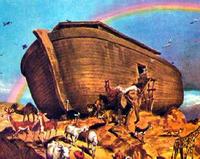What Ever Happened to Noah’s Ark Notes by Bro. Darrell W. Brown
According to the Holy Bible, Noah’s ark came to rest after the great flood on “the mountains of Ararat” (Genesis 8:4). The biblical Ararat was also known in ancient times as the land of Utartu located in Northern Mesopotamia. Today, this region is occupied by the nations of Armenia, Iran, and Turkey.
After the story of the great flood, the ark disappears from the pages of Scripture. Later biblical writers gave no mention of its whereabouts. Throughout history, however, there have been numerous reports of what looks like a large boat sighted in the mountains of the region. An early document dating back to the 3rd century B.C., says the ark was still clearly visible to the naked eye in the area.
Early Christian tradition began designating a 17,000 ft. mountain in Northern Turkey as the legendary Mount Ararat. Two Catholic monasteries shaped like boats were built during the Middle Ages and many Christians made pilgrimages to see the structures.
In the past century, there have been many aerial and satellite photos taken of unusual structures on the mountain. There have also been numerous reports from people that have claimed to seen the ark in person and even recovery of so called wooden pieces from the ark. The suggested location of Noah’s ark is above the snow line, and it has been theorized that only during exceptionally warm summers does the snow and ice melt enough to allow the ark to be visible. Complicating matters even more is that Mount Ararat has, until recently, been a sensitive border region between Turkey and the former U.S.S.R. Nevertheless, during the past two decades, numerous expeditions have explored the mountain in hopes of finding Noah’s Ark. The most famous of these expeditions was led by former NASA astronaut, James Irwin. Unfortunately none of these efforts have been a success.
Does this mean that no remnants of Noah‘s Ark exist? Who knows? Efforts continue to this day to find some sort of conclusive evidence of what might have been the most calamitous event in the history of the world. And so, like efforts to find other ancient biblical artifacts, the search goes on…

